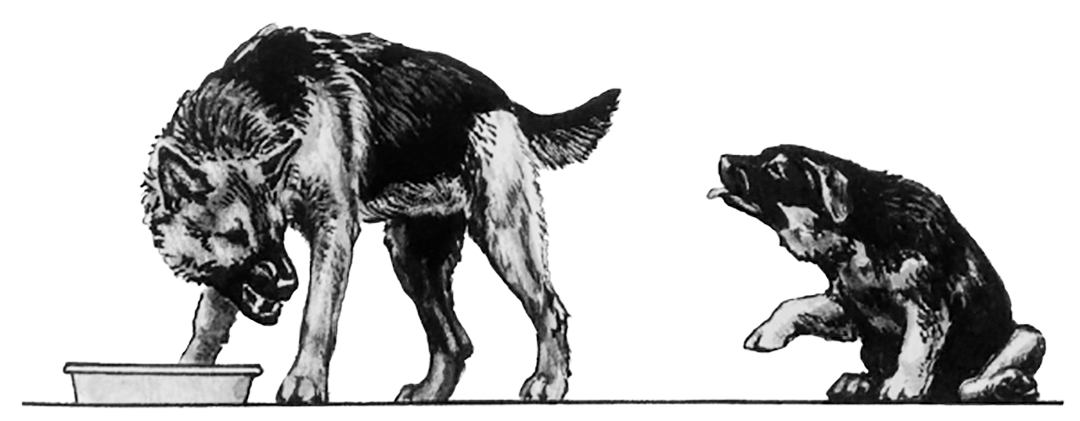The canine twist behavior is a curious behavior that few dog owners recognize, let alone know what it means.
It is a characteristic behavior shown by any canine (wolf, dog, African wild dog, and dingo, at least) when it twists one hind leg out to the side. They frequently do it from a sitting position, but they can also do it while standing. In cases where the dog appears very insecure, a half roll culminating with the dog lying on its back and presenting its belly may succeed the twist. Laid-back ears, semi-closed eyes, champing (at times with the tongue protruding out of the mouth), and paw lifting (or vacuum pawing), to various degrees depending on the level of insecurity, usually follow the twist. It’s a fairly common behavior, primarily seen in puppies and youngsters, but insecure adults can also display it.
The function of the twist is to pacify an opponent. As always, behavior happens by chance (or reflex), and if it (the phenotype) proves to have a beneficial function, it will tend to spread in the population, transmitted from one generation to the next (via its genotype).
The twist’s origin is most certainly related to the canine female’s typical maternal behavior of overturning her puppy by pressing her nose against its groin, forcing one of the puppy’s hind legs to the side. The puppy will then fall on its back, and the mother will lick its belly and genital area, facilitating the puppy’s urination and defecation. At first, the puppy seems to find it an unpleasant experience, although it soon becomes pleasurable once it rests on its back and its mother’s licking achieves its function.
Later on, the puppy will perform the same twist movement in the absence of any physical contact with the mother or any other adult. It will do it when it feels threatened or insecure and with the function of pacifying both itself and its opponent, rather than to invite belly licking. (First edition The transition from urination and defecation to pacifying is a classic of the development of behavior. It happens almost exclusively via a classic conditioning process. In the beginning, being overturned is unpleasant, but lying on its back, belly up, becomes pleasurable (due to the puppy relieving itself). After some repetitions, the puppy will associate lying on its back with ending discomfort and will readily display this behavior whenever necessary.
The strength of the twist behavior (a general characteristic of pacifying behavior) is its double effect on both parties. The puppy relaxes by doing something that has produced desirable results earlier. The threatening adult relaxes by being met with behavior it recognizes as infantile behavior.
I first described this behavior in the original edition of my book “Dog Language” in 1987 after my team recorded many observations while observing the behavior of wolf cubs and dog pups. The behavior had no name at the time. I coined it the twist behavior, thinking of the sixties’ famous dance, which was trendy in my teen years. The Beatles’ “Twist and Shout” immortalized it.* The Twist, the dance, featured a particular step where the dancer’s legs made a twisting movement reminiscent of the puppy’s pacifying behavior.
__________
* “Twist and Shout” was written by Phil Medley and Bert Russell and first released in 1961 featuring The Top Notes. However, it achieved its fame first when The Beatles performed it in 1963 with John Lennon in the lead vocals.
References
Abrantes, R. (1992/1997). Dog Language, Wakan Tanka Publishers. Naperville, IL. First edition 1987. ISBN-13: 9780966048407. ISBN-10: 0966048407.
Abrantes, R. (1997/2005). The Evolution of Canine Social Behavior. Wakan Tanka Publishers, Naperville, IL. ISBN-10: 0966048415. ISBN-13: 978-0966048414.
Chance, P. (2003). Learning and Behavior. Wadsworth — Thomson Learning, Belmont, CA, 5th, ed. ISBN-13: 978111183277. ISBN-10: 1111832773.
Fox, M. W. (1971). Behaviour of Wolves, Dogs and Related Canids. Harper & Row. ISBN-13: 9780060113216. ISBN-10: 0060113219.
McFarland, D. (1999). Animal Behavior. Pearson Prentice Hall, England. 3rd ed. ISBN-13: 9780582327320. ISBN-10: 0582327326.
McFarland, D. J. (1971). Feedback Mechanisms in Animal Behaviour. Academic Press, London. ISBN-13: 9780124838505. ISBN-10: 0124838502.
Mech, D. (1970). The Wolf: the Ecology and Behavior of an Endangered Species. Natural History Press, NY. ISBN-13: 9780816610266. ISBN-10: 0816610266.
Scott, J. P. (1962). Critical periods in behavioral development. Science. 138, 949-958. DOI: 10.1126/science.138.3544.949.
Scott, J. P. (1985). Animal behavior. Chicago: University of Chicago Press. ISBN-13: 9780226743363. ISBN-10: 0226743365.
Scott, J. P. and Fuller, J. L. (1965). Dog Behavior. The Genetic Basis. University of Chicago Press, Chicago, IL. ISBN: 0-226-74335-7.
Trumler, E. (1971). Mit dem Hund auf Du. Bechtermünz Verlag, Augsburg. ISBN-13: 9783492111355. ISBN-10: 3492111351.
Zimen, E. (1981). The Wolf – his Place in the Natural World. Souvenir Press. ISBN-10: 0285624113. ISBN-13: 978-0285624115.
Featured image: The canine Twist behavior from “Dog Language” (Illustration by Alice Rasmussen).
Feel free to leave a comment, pose a question, or share your thoughts. Your opinion matters. I will reply to all messages and answer all questions to the best of my ability.
